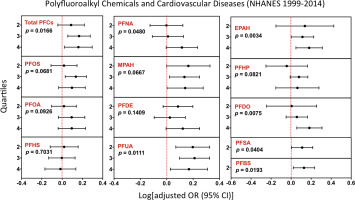Environment International ( IF 11.8 ) Pub Date : 2018-06-19 , DOI: 10.1016/j.envint.2018.05.051 Mengmeng Huang , Jingjing Jiao , Pan Zhuang , Xinyu Chen , Jun Wang , Yu Zhang

|
Background
Perfluoroalkyl chemicals (PFCs) as possible cardiovascular disrupters are universally detected in humans. However, evidence from epidemiological studies appears insufficient and ambiguous.
Objectives
We aim to examine the serum PFCs levels and their associations with the prevalence of cardiovascular diseases (CVD) and related outcomes in general US population.
Methods
We investigated the serum levels of 12 major PFCs, including perfluorooctanoic acid (PFOA), perfluorooctane sulfonic acid (PFOS), perfluorohexane sulfonic acid (PFHxS), 2-(N-ethyl-perfluorooctane sulfonamido) acetate (EPAH), 2-(N-methyl-perfluorooctane sulfonamido) acetate (MPAH), perfluorodecanoic acid (PFDE), perfluorobutane sulfonate (PFBS), perfluoroheptanoic acid (PFHP), perfluorononanoic acid (PFNA), perfluorooctane sulfonamide (PFSA), perfluoroundecanoic acid (PFUA), and perfluorododecanoic acid (PFDO), in 10,859 participants from the National Health and Nutritional Examination Survey (NHANES) 1999–2014. Logistic regression models were used to estimate the associations between serum PFCs and 5 self-reported CVD outcomes, including congestive heart failure, coronary heart disease, angina pectoris, heart attack, and stroke. Linear regression analyses were used to estimate the PFCs and their associations with 8 traditional CVD risk factors like serum triglyceride and total cholesterol.
Results
In multivariable-adjusted models, total PFCs were positively associated with total CVD (p for trend = 0.0166), independent of traditional CVD risk factors, such as smoking status, diabetes, hypertension and serum cholesterol level. Compared with reference quartile of total PFCs levels, the multivariable adjusted odds ratios in increasing quartiles were 1.23 [95% confidence interval (CI): 0.91–1.66], 1.47 (95% CI: 1.14–1.89) and 1.45 (95% CI: 1.06–1.98) for total CVD. Similar positive associations were found if considering individual PFCs including PFOS, PFUA, MPAH, EPAH, PFDO, PFSA and PFBS. In addition, serum levels of MPAH and PFDO were positively associated with congestive heart failure; PFNA, PFDE, and PFUA were positively associated with coronary heart disease; PFUA and PFDO were positively associated with angina pectoris; and PFNA was positively associated with heart attack.
Conclusions
Our findings suggested that exposure to PFCs was positively associated with risk of CVD. Further longitudinal studies are needed to increase our understanding about the role of PFCs exposure in the prevalence of CVD.
中文翻译:

血清多氟烷基化合物与美国国民心血管疾病的风险有关
背景
全氟烷基化学物质(PFCs)可能是造成心血管疾病的干扰物,已在人类中普遍发现。然而,流行病学研究的证据似乎不足且模棱两可。
目标
我们旨在检查全美人群的血清PFCs水平及其与心血管疾病(CVD)的患病率和相关结局的关系。
方法
我们调查了12种主要PFC的血清水平,包括全氟辛酸(PFOA),全氟辛烷磺酸(PFOS),全氟己烷磺酸(PFHxS),2-(N-乙基-全氟辛烷磺酰胺基)乙酸酯(EPAH),2-(N-甲基全氟辛烷磺酰胺基乙酸盐(MPAH),全氟癸酸(PFDE),全氟丁烷磺酸盐(PFBS),全氟庚酸(PFHP),全氟壬酸(PFNA),全氟辛烷磺酰胺(PFSA),全氟十一烷酸(PFUA)和全氟十二烷酸(PFDO),来自1999-2014年美国国家健康与营养检查调查(NHANES)的10,859名参与者。使用逻辑回归模型估计血清PFC与5种自我报告的CVD结果之间的关联,包括充血性心力衰竭,冠心病,心绞痛,心脏病发作和中风。线性回归分析用于估计PFC及其与8种传统CVD危险因素(如血清甘油三酸酯和总胆固醇)的关系。
结果
在多变量调整模型中,总PFC与总CVD正相关(p(趋势= 0.0166),与传统的CVD危险因素无关,例如吸烟状况,糖尿病,高血压和血清胆固醇水平。与总PFC水平的参考四分位数相比,增加的四分位数中的多变量调整后的优势比为1.23 [95%置信区间(CI):0.91-1.66],1.47(95%CI:1.14-1.89)和1.45(95%CI: 1.06–1.98)用于总CVD。如果考虑单独的PFC,包括PFOS,PFUA,MPAH,EPAH,PFDO,PFSA和PFBS,则发现相似的正关联。另外,MPAH和PFDO的血清水平与充血性心力衰竭呈正相关。PFNA,PFDE和PFUA与冠心病呈正相关。PFUA和PFDO与心绞痛呈正相关。PFNA与心脏病发作呈正相关。
结论
我们的发现表明,接触PFC与CVD的风险呈正相关。需要进一步的纵向研究,以加深我们对PFCs暴露在CVD患病率中的作用的了解。


























 京公网安备 11010802027423号
京公网安备 11010802027423号